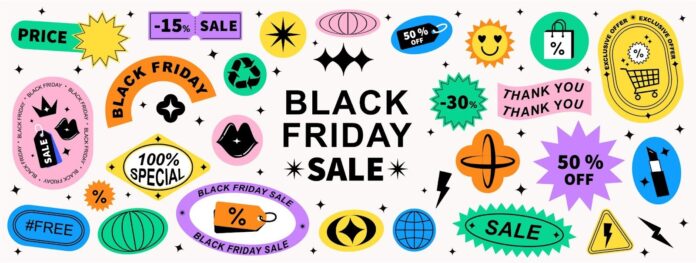As one of the biggest shopping events of the year, Black Friday presents a key opportunity for brands to engage with their customers and dramatically boost sales. Many customers accomplish the majority of their holiday shopping the day after Thanksgiving and are prepared to spend big on deals and promotions.
Building anticipation in advance is crucial for making the most of this consumer holiday, and creating effective buzz for your brand requires a strong marketing game plan.
Why Focus on Black Friday?
The day after Thanksgiving — AKA Black Friday — kicks off the holiday shopping season for businesses and consumers alike. Consumers are eager to snap up the savings and sales businesses often run over this weekend, while for many, Black Friday alone represents record-breaking sales numbers.
“We’re seeing a lot of people leaning on savings and debt to afford these purchases,” says e-commerce analyst Claire Tassin. In other words, consumers are willing to spend more than they normally would to snap up those holiday deals.
10 Marketing Tips for Black Friday
With the sales potential of Black Friday in mind, it’s never too early to lay the groundwork for a strong holiday marketing campaign. Consumers are inundated with eye-catching ads and holiday gift campaigns this time of year, so take the time to make sure your brand stands out among the masses.
As advertising tycoon David Ogilvy said, “The consumer isn’t a moron; she’s your wife.” Remember that you’re marketing to other consumers just like yourself.
1. Develop a Strong Email Marketing Campaign
Social media marketing might be the way of the future, but for now, email marketing is still the tried-and-true bread and butter of connecting with your consumer base. It’s the most efficient way of communicating directly with a vast number of customers and letting them know what your business is doing for Black Friday.
“Don’t neglect the possibilities of a good email campaign,” says Matt Masiello, Chief Marketing Officer of BabyBuddha. “For many consumers, email is the first thing they check in the morning. It’s the quickest way to get them thinking about your brand.”
Best practices for email marketing campaigns include clear and enticing subject lines, strong branding, and personalized offers to customer segments based on their purchase history or interests.
2. Content Is King
Persistence and repetition are powerful marketing tools, but so is another concept: Quality. Invest time into creating thoughtful, engaging content, such as targeted gift guides, how-to articles, or short-form videos based on trending content revolving around your products.
Marcus Hutsen, Business Development Manager of Patriot Coolers says that “Today’s consumers want to be entertained. Their attention span is shorter, and their appetite for personalized content is higher. Curate content based on those metrics.”
You can distribute high-quality content via your email marketing campaign, traditional ads, or posted on your website. However, possibly the best marketing avenue is relatively new: Social media.
3. Utilize Social Media

Photo Source: Adobe Stock
Social media is always a powerful marketing tool, but it can be especially useful for generating anticipation weeks ahead of a campaign (such as Black Friday). One of the best ways to do this is by encouraging user-generated content through a giveaway or contest.
“Running a giveaway on Instagram tied to story shares or tags can significantly increase engagement,” says Victor Mathieux, Co-Founder and CEO of Miracle Brand. “A lot of the time, that engagement directly translates into sales.”
Pay attention to what’s trending on social media and which demographics your brand appeals to. Create a TikTok marketing strategy geared towards social media content that’s meaningful and interesting for your core audience, and you’ll find you’re getting a much higher conversion rate than you would with a broader marketing campaign.
4. Are Influencers Right for Your Brand?
Depending on the size and scope of your business, consider tapping into the power of influencer marketing. Consumers tend to prefer buying products from people they trust and relate to, even if that relationship is one-sided.
“These days, social media influencers and YouTube creators have all the buying power in their back pockets,” says Scott Chaverri, CEO of Mito Red Light, a company that helps consumers experience red light therapy at home. “Consumers pay attention to them more than your traditional celebrity.”
Even relatively small businesses should consider tapping local micro-influencers if they’re a good match for your industry. Word of mouth is a powerful form of marketing, even if nowadays it spreads online rather than in person.
5. Exclusive Access
If you have a membership or customer rewards program, consider offering them early or exclusive access to your Black Friday sales. The benefits are threefold: Your customers feel valued, other customers are incentivized to join the rewards program, and it builds hype leading up to Black Friday.
“Email campaigns and customer loyalty programs tend to go hand-in-hand,” says Jin Young Woo, CEO of Like Dreams. “It’s a guaranteed way to drive interest before the holiday season.”
Just be sure to notify your customers of this opportunity ahead of time with pre-sale invitations via email and an information campaign on your website and social media.
6. Let a Teaser Campaign Do the Work
Use a teaser holiday campaign to inform consumers about the exclusive access they can get with the customer rewards program. Focus on a cohesive message and branding, and notify customers with the usual channels: Your website, social media platforms, email blasts, and traditional advertisements.
“Using countdown timers and hints at the huge savings to come can create suspense leading up to Black Friday,” says Mara Dumski, Chief Fragrance Experience Officer of Pura, a company known for their smart Car Diffuser. “Even weeks or months before the holidays begin, it gets customers thinking about what they want to spend on.”
With a well-thought-out teaser campaign, the anticipation of what’s to come does half the work for you.
7. Optimize Your Website
A well-designed website is always important, but in the lead-up to the holiday season, it’s vital to make sure your website is optimized for mobile browsing.
Dean Arbit, Co-Founder and CEO of bud.com, a company that helps consumers buy weed online, says, “A frictionless checkout process online is essential. That’s the whole point of online shopping — the ease.”
Frictionless checkout, quick loading times, easy navigation on tablets and smartphones — all these things contribute to a more enjoyable shopping experience, which then leads to sales and conversions. If you aren’t a website expert, hire someone who is. It’s worth ensuring your customers have the best shopping experience possible with your business.
8. Test Out Retargeting Ads
Retargeting ads can hook customers who are on the fence about buying a product and just need a little nudge. They’re the marketing equivalent of the “Don’t forget about these items in your cart” email (which, by the way, is also a great tactic).
“The vast majority of first-time customers to a website don’t end up buying anything,” says Dr. Fred Melius MD, CEO of BioSpectrum Hemp. “It’s after they visit the website two, three, four times that they end up spending. Those are the customers you want to advertise to.”
Retargeting campaigns are a low-budget way to remind customers about your brand and the items they may have forgotten when they left your website. It will build visibility and loyalty towards your brand, which is essential in the weeks leading up to the holiday shopping season.
9. Create a Sense of Urgency
Nothing strikes urgency into the heart of a customer quite like the fear that they might miss out on massive savings. When crafting your holiday campaigns, use phrases like “ending soon” or “while supplies last” to encourage your consumers to strike while the iron is hot.
“Limited-time offers and persuasive language can do a lot of legwork as far as motivating customers goes,” says Adam Greenberg, Co-Founder of One Bone, a company that specializes in big and tall men’s clothing. “No one wants to miss out on the deal of the year.”
Aside from using urgent language, running flash sales and countdowns to promotions can also build hype around a Black Friday sale. The key takeaway for the consumer is that if they don’t act quickly, they’ll have to pay more later — which absolutely no one wants to do.
10. Check In on Your Campaign
Finally: Monitor your campaign while it’s occurring, and make adjustments in real time if necessary. Metrics such as conversion and click-through rates can provide key data to help you figure out what’s working and what’s not.
“A bloated marketing budget is no one’s friend,” says Stephanie Venn-Watson, CEO of Fatty15. “Those key performance indicators should always support your chosen marketing strategy, not the other way around.”
Not only will making changes in real time help you save money on unnecessary marketing tools, but this strategy can also actively boost sales and conversion rates. For example, if your micro-influencer program is working well, don’t be afraid to invest more into it, even if it means slashing a less-productive strategy.
Get Ready for Black Friday
Black Friday presents a huge opportunity for businesses of all sizes. Don’t let this holiday season slip by you — start planning your marketing strategy now and watch all the buzz pay off this November.







